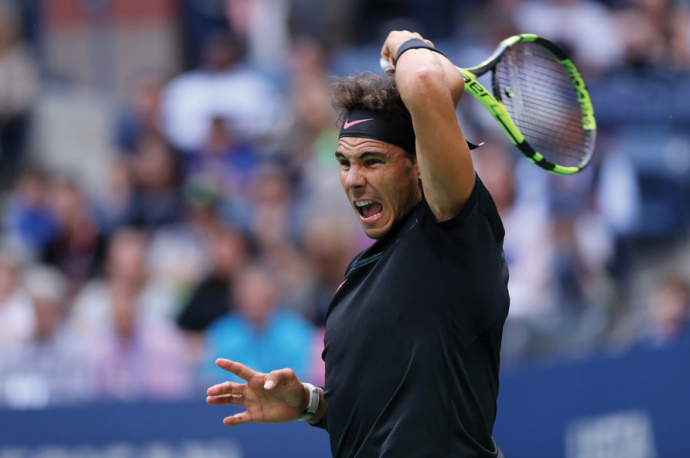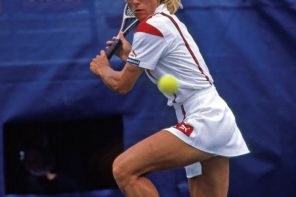This is a big year for sporting anniversaries, with few bigger than the golden jubilee of the Open Era — when the four Grand Slam tournaments (Wimbledon and the Australian, French and US Opens) “opened” competition to professional as well as amateur players.
Ten years later, in 1978, the US Open, formerly known as the U.S. National Championships, moved from the tony, intimate Westside Tennis Club in Forest Hills, Queens, 3 miles north to the new USTA National Tennis Center in Flushing Meadows — the world stage that the US Open demanded.
But it wasn’t merely a journey in miles from a bucolic private club to a boisterous public setting. It was one that can be measured in milestones that reflected America’s shifting attitudes toward workers’ and women’s rights and the resurrection of New York City, back from the financial brink.
Few have been better positioned to observe those milestones than longtime tennis journalist Steve Flink, author of the indispensable “The Greatest Tennis Matches of All Time” (New Chapter Press) and a 2017 inductee into the International Tennis Hall of Fame. WAG caught up with the Katonah resident shortly before he left for Wimbledon and enjoyed serving and volleying verbally with this writer of encyclopedic recall and thought-provoking opinions. Perhaps not so coincidentally, he said, the early years of the Open Era dovetailed with the formation of the players’ unions and tours, including the Virginia Slims Circuit, founded in 1970 by Billie Jean King and eight other players, along with World Tennis magazine publisher Gladys Heldman.
“The women were making one-tenth of what the men were making,” Flink remembered. “It was a necessary thing. They were going to establish themselves.” Which they did, with the Virginia Slims tour becoming the Women’s Tennis Association in 1973. A year earlier, the men had formed the Association of Tennis Professionals at the US Open. (World Team Tennis, founded in part by King and her then-husband, Larry King, began in 1974.)
The early years of the Open Era (the mid-1970s) also saw what Flink called a “tennis boom” — which was not unlike the ballet boom of the same period, led by Mikhail Baryshnikov’s defection to the West. Jimmy Connors, Björn Borg and Chris Evert were among the great players to emerge, with Flink singling out the scrappy Connors as the central figure of the Open Era: “He was important in bringing in new, blue-collar fans.”
Counterbalanced by the elegant Arthur Ashe, Connors would give way to John McEnroe and Ivan Lendl; Boris Becker, Pete Sampras and Andre Agassi; and, ultimately, the quartet of men who have dominated tennis in recent years — Roger Federer, Rafael Nadal, Novak Djokovic and Andy Murray. The parade of female stars is no less impressive, including Martina Navratilova, Steffi Graf, Monica Seles and Venus and Serena Williams.
Inevitably, any tennis conversation rolls around to GOAT — greatest of all time (though perhaps that should be GTD, greatest to date, since time mercifully hasn’t ended).
Though Serena Williams is considered by many, including Tennis magazine, to be the greatest female player, Flink is reserving judgment to see if Williams, who has 23 singles Slam titles, can surpass the record of Margaret Court, who has 24. Flink also cites Navratilova, winner of 18 Slam singles titles and the only player to hold the top ranking in singles and doubles play for more than 200 weeks; as well as Graf, holder of 22 Slam singles titles and the only player to win the Golden Slam — the Grand Slam plus the Olympic gold medal, which she did in 1988.
As for the men, Flink said, “on record, it’s hard to deny Federer, a player of such enduring excellence,” marked by an unprecedented (for a man) 20 Slam titles. Could Nadal — with 16 Slams, mostly on French Open clay — surpass him? He’d have to up his game and do better on Wimbledon grass, Flink said.
Regardless, though, he added that if he could put all the men at their best in a time warp, he would select Sampras as GOAT, he of the peerless first and second serves. Sampras also figures in the greatest match Flink has ever seen — a 2001 quarterfinal showdown against longtime rival Agassi under the lights at the US Open. Perhaps the game’s best server, Sampras went up against one of the game’s best returners in an epic battle that went to four tiebreaks (the US Open instituted the use of the tiebreak in Slam tournaments), with neither man ever losing his serve. In the end, Sampras prevailed 6-7 (7), 7-6 (2), 7-6 (2), 7-6 (5).
Other favorite Flink matches include two semifinals in which Djokovic came back to beat Federer (in 2010 and ’11), the latter from two sets down that featured an incredible, seat-of-the-pants return.
Though people speak of the Federer-Nadal rivalry — known to fans as “Fedal” — Flink does not discount Nadal-Djokovic (called “Rafanole,” for their nicknames), or Federer-Djokovic.
The latter appeared in a memorable 2015 US Open final, Flink said, in which the Djoker had to battle not only Fed but the pro-Fed crowd that had been drinking steadily through a three-hour rain delay. It was a gutsy triumph over not only Fed but one of the toughest places on the tour, rivaled, Flink said, only by the French Open.
“What makes the US Open so tough is the heat coming off the hard courts.” (In the Forest Hills days, the U.S. championship was contested first on grass, with players complaining of wicked bounces, and the last three years on clay.)
Along with the heat come the planes headed to and from LaGuardia and JFK and the overall rollicking atmosphere. These have been somewhat mitigated by the retractable roofs over Arthur Ashe Stadium and, now, the new Louie — Louis Armstrong Stadium.
“The roof has added character,” Flink said.
Something that the Open Era and US Open have both always had plenty of.
The US Open will be contested Aug. 27 through Sept. 9. For tickets and more, visit usopen.org.





